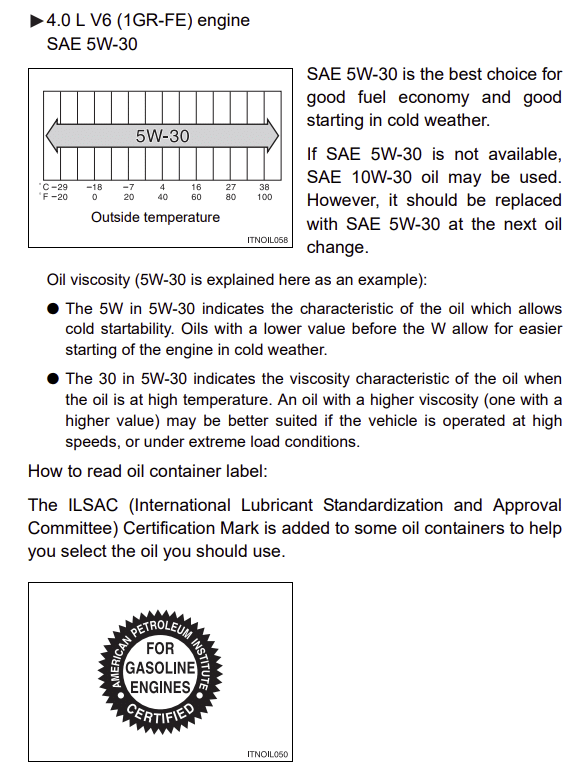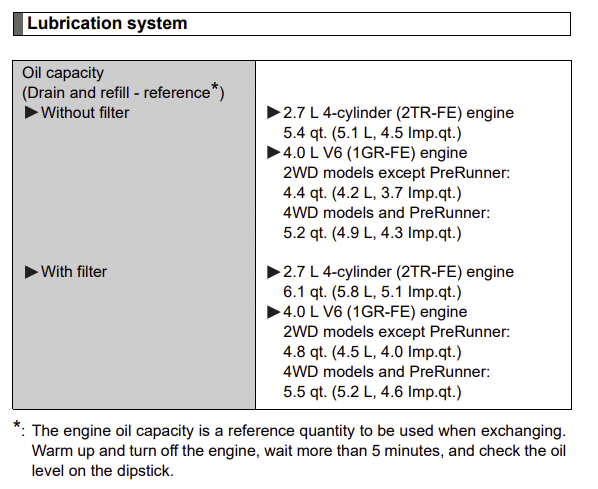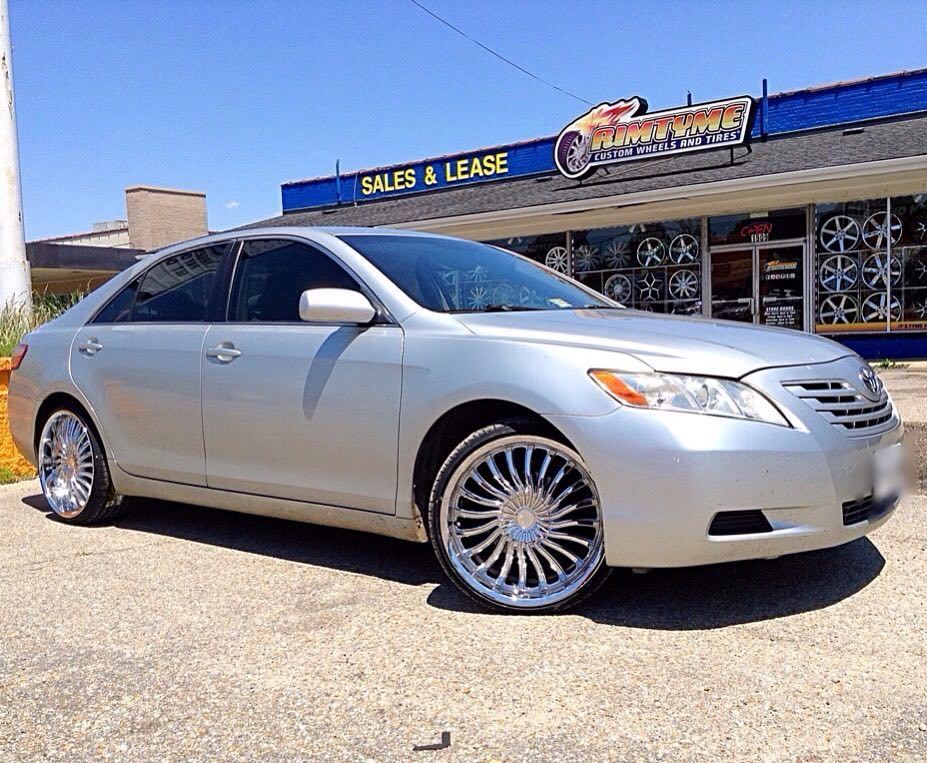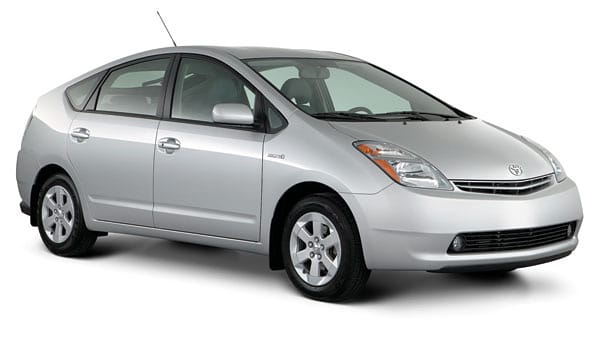The 2013 Toyota Tacoma is a versatile and reliable midsize pickup truck known for its durability and strong resale value. Available in various configurations, including Access Cab, Double Cab, and Regular Cab, the Tacoma offers a choice between two engine options: a 2.7 L 4-cylinder (2TR-FE) and a 4.0 L V6 (1GR-FE) engine. With features like an attractive design, comfortable interior, and off-road capabilities, the 2013 Tacoma has continued to be a popular choice among truck enthusiasts.
Selecting the appropriate oil type for your 2013 Toyota Tacoma is crucial for maintaining its performance, fuel efficiency, and engine longevity. Using the right oil ensures proper lubrication and protection of the engine’s internal components, reducing friction and wear. Additionally, the correct oil type aids in cooling, heat dissipation, and the removal of engine contaminants, keeping your Tacoma’s engine in top condition.
Following the manufacturer’s recommendations for oil type and maintenance will not only prolong your truck’s life but also provide a better overall driving experience.
What Type Of Oil Does A 2013 Toyota Tacoma Take?
For the 2013 Toyota Tacoma equipped with a 2.7 L 4-cylinder (2TR-FE) engine, the owner’s manual recommends using SAE 0W-20 oil. This oil provides good fuel economy and reliable cold-weather starting performance.

For the 4.0 L V6 (1GR-FE) engine, the owner’s manual recommends SAE 5W-30 oil. This oil type also ensures good fuel economy and optimal starting performance in cold weather conditions.

If SAE 0W-20 is not available for the 2.7 L 4-cylinder engine, SAE 5W-20 may be used as a temporary alternative. However, it is essential to switch back to SAE 0W-20 at the next oil change. For the 4.0 L V6 engine, if SAE 5W-30 is unavailable, SAE 10W-30 may be used temporarily but should also be replaced with SAE 5W-30 during the subsequent oil change. It is crucial to consider the impact of climate and driving conditions when choosing an alternative oil viscosity.
How Much Oil Does A 2013 Tacoma Take?
For the 2013 Toyota Tacoma 2.7 L 4-cylinder (2TR-FE) engine, the oil capacity (drain and refill) with the filter is 6.1 qt. (5.8 L, 5.1 Imp.qt.).

For the 4.0 L V6 (1GR-FE) engine, the oil capacity varies by model:
- 2WD models except for PreRunner: 4.8 qt. (4.5 L, 4.0 Imp.qt.)
- 4WD models and PreRunner: 5.5 qt. (5.2 L, 4.6 Imp.qt.)
Engine Specifications of the 2013 Toyota Tacoma
The 2.7 L 4-cylinder (2TR-FE) engine is an inline four-cylinder, DOHC engine with 16 valves and VVT-i (Variable Valve Timing with intelligence) technology. It has a displacement of 2,694 cc and offers a balance of power and fuel efficiency, making it suitable for daily driving and light-duty tasks.
The 4.0 L V6 (1GR-FE) engine is a more powerful option for the 2013 Toyota Tacoma. This engine features a DOHC design with 24 valves and VVT-i technology, providing increased performance and efficiency. With a displacement of 3,956 cc, this engine is ideal for drivers seeking additional power for towing, off-roading, or more demanding tasks.
For the 2.7 L 4-cylinder (2TR-FE) engine, the power output is 159 hp at 5,200 rpm, and the torque output is 180 lb-ft at 3,800 rpm. The 4.0 L V6 (1GR-FE) engine delivers a power output of 236 hp at 5,200 rpm and a torque output of 266 lb-ft at 4,000 rpm.
Both engines in the 2013 Toyota Tacoma come equipped with VVT-i technology, which optimizes the timing of the intake and exhaust valves according to engine speed and load. This technology results in improved fuel efficiency, lower emissions, and increased power and torque across the entire RPM range. Additionally, the engines utilize an electronic throttle control system with intelligence (ETCS-i) for more precise throttle control, further enhancing performance and fuel economy.
Role of Engine Oil in Your 2013 Toyota Tacoma
Engine oil plays a crucial role in the lubrication and protection of your Tacoma’s engine components. By creating a thin film between moving parts, it minimizes friction and wear, ultimately prolonging the life of the engine. The right oil type ensures that all engine components are properly lubricated under various driving conditions.

Aside from lubrication, engine oil also contributes to cooling and heat dissipation. As the oil circulates throughout the engine, it absorbs heat generated by the combustion process and friction between moving parts. The oil then releases this heat as it flows through the oil cooler and oil pan, helping to maintain optimal engine operating temperatures.
Engine oil contains additives designed to clean and remove contaminants such as dirt, carbon deposits, and metal particles. These additives help to prevent the buildup of sludge and other deposits, ensuring that the engine remains clean and functions efficiently. Regular oil changes are essential for maintaining the effectiveness of these additives and keeping your engine clean.
Using the recommended engine oil for your 2013 Toyota Tacoma can also enhance fuel efficiency and performance. High-quality oils with the appropriate viscosity reduce internal friction within the engine, allowing it to operate more efficiently. This leads to better fuel economy and overall performance, providing an improved driving experience.
Understanding Oil Viscosity
Oil viscosity refers to the thickness or resistance to flow of a particular oil type. Viscosity ratings, such as 0W-20 or 5W-30, are determined by the Society of Automotive Engineers (SAE) and indicate the oil’s performance under specific temperature conditions. The first number followed by the letter “W” (which stands for winter) represents the oil’s cold startability or low-temperature performance. In contrast, the second number indicates the oil’s high-temperature viscosity.
The lower the first number (before the “W”), the better the oil’s cold startability. Lower viscosity oils flow more easily at colder temperatures, ensuring proper lubrication and protection of the engine during cold starts. The second number represents the oil’s high-temperature viscosity, which determines how well it maintains its thickness and provides adequate lubrication under high-temperature conditions. A higher number indicates better performance at high temperatures, which is crucial when operating the vehicle at high speeds or under heavy loads.
When selecting an oil viscosity, it’s essential to consider the operating conditions that your vehicle will be subjected to. Climate and driving conditions play a significant role in determining the most suitable oil viscosity for your 2013 Toyota Tacoma.
For instance, lower viscosity oils (e.g., 0W-20) are recommended for vehicles operating in colder climates, as they provide better cold start performance. On the other hand, higher viscosity oils (e.g., 5W-30) may be more suitable for vehicles driven at high speeds, under heavy loads, or in hot climates, as they maintain their protective properties under these demanding conditions.
How to Check and Add Engine Oil
Tools and materials needed:
- Clean, lint-free cloth or paper towel
- Engine oil of the recommended type and viscosity
- Funnel (optional, but helpful for avoiding spills)
Step-by-step guide to checking oil level
- Park your 2013 Toyota Tacoma on a level surface and ensure the engine is turned off. Wait for a few minutes to let the oil settle.
- Open the hood and locate the engine oil dipstick. It usually has a yellow or orange handle.
- Pull the dipstick out and wipe it clean with the cloth or paper towel.
- Reinsert the dipstick fully, then pull it out again to check the oil level.
- Examine the oil level on the dipstick. The level should be between the “Low” and “Full” marks. You’ll need to add oil if it’s below the “Low” mark.
Adding engine oil in small quantities
- Locate the oil filler cap on the engine. It’s typically labeled with the recommended oil type or an oil can icon.
- Remove the oil filler cap and place a funnel into the opening to avoid spills.
- Slowly pour the recommended engine oil into the funnel, adding small amounts at a time.
- Periodically recheck the oil level with the dipstick to ensure you don’t overfill the engine. Add oil until the level is within the “Low” and “Full” marks.
- Once the oil level is correct, remove the funnel and securely replace the oil filler cap. Close the hood and start the engine, allowing it to run for a few minutes to circulate the oil.
Tips for avoiding overfilling and ensuring proper oil level
- Be patient when adding oil, as it can take some time for the oil to reach the oil pan and reflect the correct level on the dipstick.
- Avoid overfilling, as this can cause engine damage or leaks. If you accidentally overfill the engine, drain some oil or have a professional do it for you.
- Check the oil level regularly, ideally at every fuel fill-up or at least once a month, to ensure your engine has enough oil for optimal performance and protection.
Oil Change Interval for the 2013 Toyota Tacoma
Several factors can influence the frequency at which you need to change your engine oil, including:
- Driving conditions: Frequent short trips, stop-and-go traffic, driving in dusty or extreme temperature conditions, or towing heavy loads can cause your engine oil to degrade more quickly, requiring more frequent oil changes.
- Oil type: Synthetic oil generally lasts longer and provides better protection than conventional oil, potentially allowing for longer oil change intervals. However, always follow the manufacturer’s recommendations for your vehicle.
- Engine age and wear: Older engines or engines with higher mileage may require more frequent oil changes due to increased wear or oil consumption.
Used Engine Oil Safety and Disposal
Used engine oil contains harmful contaminants, such as heavy metals and toxic chemicals, which can pose risks to both human health and the environment. Prolonged and repeated contact with used engine oil may cause skin disorders, such as inflammation or even skin cancer. Additionally, if ingested or inhaled, used engine oil can cause serious health problems.
To minimize the risks associated with used engine oil, follow these handling and disposal guidelines:
- Wear protective gloves when handling used engine oil to minimize skin contact.
- To remove used engine oil from your skin, wash thoroughly with soap and water.
- Store used engine oil in a sealed container, away from children and pets.
- Do not dispose of used engine oil in household trash, sewers, or on the ground, as this can cause soil and water contamination.
- Contact your local Toyota dealer, service station, or auto parts store for information on proper recycling or disposal facilities. Many places have designated collection centers where you can safely dispose of used engine oil and oil filters.
Proper disposal of used engine oil is essential to protect the environment. When disposed of improperly, used engine oil can contaminate soil, water sources and harm wildlife. By recycling used engine oil, you help conserve valuable resources, as recycled oil can be re-refined into new lubricating oil or used as a base stock for other petroleum products. Always follow local regulations and guidelines when disposing of used engine oil to help protect the environment and maintain a sustainable future.
Frequently Asked Questions about Oil Type and Maintenance
Does a 2013 Toyota Tacoma use synthetic oil?
The 2013 Toyota Tacoma owner’s manual recommends using synthetic oil for the 2.7 L 4-cylinder (2TR-FE) engine. SAE 0W-20 synthetic oil is the best choice for good fuel economy and good starting in cold weather. If SAE 0W-20 is not available, SAE 5W-20 oil may be used, but it must be replaced with SAE 0W-20 at the next oil change.
For the 4.0 L V6 (1GR-FE) engine, the recommended oil is SAE 5W-30. Although the owner’s manual does not explicitly state the use of synthetic oil for this engine, it is generally considered a good practice to use synthetic oil for improved engine protection, performance, and extended oil change intervals. If SAE 5W-30 is not available, SAE 10W-30 oil may be used, but it should be replaced with SAE 5W-30 at the next oil change.
Can I use a different viscosity grade than recommended?
Using a different viscosity grade than recommended by the manufacturer is generally not advised, as it may affect engine performance, fuel efficiency, and component wear. The recommended oil viscosity is selected based on the specific needs and operating conditions of your vehicle. If you need to use a different viscosity due to extreme temperatures or other unique circumstances, consult your vehicle owner’s manual or a professional mechanic for guidance.
What are the signs of needing an oil change?
Some common signs that your vehicle may need an oil change include:
- Dark and dirty oil: Clean oil is amber in color. If the oil on your dipstick appears dark, dirty, or thick, it is likely time for an oil change.
- Increased engine noise: If your engine seems louder or produces more noise than usual, it could be an indication that the oil is no longer providing adequate lubrication.
- Check engine or oil change warning lights: Modern vehicles often have sensors that monitor oil life and alert you when it is time for an oil change.
- Decreased fuel efficiency: Worn-out engine oil can cause a decrease in fuel efficiency due to increased friction and reduced lubrication.
- Exceeding the recommended oil change interval: Always follow the manufacturer’s recommended oil change frequency for your vehicle.
Conclusion
Using the appropriate oil type and following a regular maintenance schedule are crucial for the optimal performance and protection of your 2013 Toyota Tacoma engine. Choosing the right oil viscosity ensures that your engine remains well-lubricated under various operating conditions, reducing friction and wear on engine components.
Adhering to the owner’s manual recommendations for oil type, viscosity, and maintenance intervals will help you maintain the performance, fuel efficiency, and reliability of your 2013 Toyota Tacoma. Proper engine care not only contributes to a longer-lasting vehicle but also ensures a smoother and more enjoyable driving experience.


















